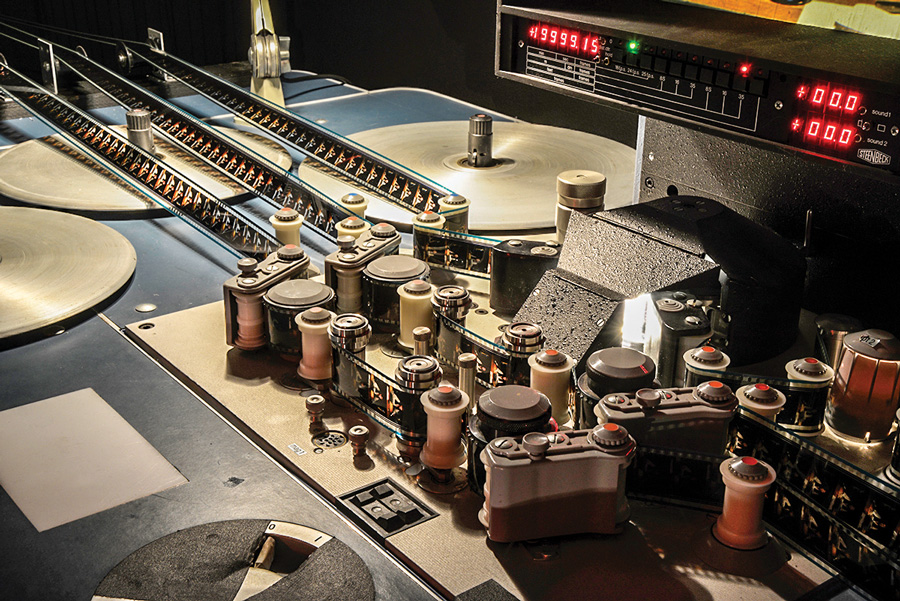Egoyan’s spiderweb of film and footage has layers of meaning

Art | by Gregory Beatty
Atom Egoyan: Steenbeckett
Mackenzie Gallery
Until Jan. 1
I’ve been writing on the arts for a long time, and I don’t think I’ve ever seen a better exhibition title than Steenbeckett. At one word, it’s as concise as you can get. But it perfectly captures the arc of this installation by Canadian filmmaker Atom Egoyan, which opened at the MacKenzie Gallery as part of Meet In the Middle in early November.
First, a bit about Meet In the Middle. Organized by Strandline Curatorial Collective with various community partners, it’s included several exhibitions and events over the last two years, all of which explore the intersection between visual art and film in themes of migration, memory and trauma.
Egoyan was born in Cairo in 1960, and later moved with his family to Victoria. Currently based in Toronto, he’s often explored similar themes in his three decade-plus film career. So he was a natural fit for MITM, which has also showcased work by Saskatchewan filmmakers and engaged with artists from Egoyan’s ancestral home of Armenia.
Steenbeckett was first displayed at London’s Museum of Mankind in 2002, and this is its North American premiere. The title is an amalgam of two major elements in the show. The first is a Steenbeck flatbed editing suite, which was the industry standard for 16mm and 35mm film in the pre-digital era. The second is an excerpt from Egoyan’s film version of Samuel Beckett’s 1958 stage play Krapp’s Last Tape. So you’ve got Steenbeck + Beckett = Steenbeckett.
Steenbeckett has to be seen to be believed. If you’ve seen it already, you’ll know what I mean. If you haven’t, imagine being inside a giant film projector as the sprockets rotate and light flickers to produce the larger-than-life images that have so captivated audiences since film’s emergence as an art/entertainment medium in the early 20th century.
It’s not a totally immersive experience, since you have to keep a certain distance for safety reasons. But when you first enter the darkened gallery through heavy curtains you’re met by a chaotic web of film that crisscrosses the gallery wall-to-wall and floor-to-ceiling.
Projected on another wall is Egoyan’s excerpt from Krapp’s Last Tape. Starring English actor John Hurt, it was produced for a 2001 project called Beckett on Film. Situated between the projection and the relentlessly whirring strips of celluloid is a film-editing suite made of hardwood with an inset light box and metal cranks.
In the darkened gallery, the light is a little hard on the eyes. But when you approach, you see that the footage that’s being “edited” is from Egoyan’s Beckett shoot. These days you can edit at the click of a mouse. But in the old days, directors would pore over multiple takes of each scene with film editors, doing the analog equivalent of “cut and paste” with a blade and tape or glue to compose the finished film.
It was painstaking work, and coupled with multiple strips of film that cascade to the floor beside the editing suite, and a nearby shelf containing over a dozen film canisters and spools (some empty, some full), the installation delivers a visceral meditation on the physicality of film — a meditation that, with the proliferation of digital media in recent years, is significantly more poignant now than when Steenbeckett debuted in 2002.
That poignancy, in turn, adds an extra layer of meaning to the excerpt from Beckett’s play that screens as part of Steenbeckett.
The play takes place on the 69th birthday of a writer named Krapp (scatological reference intended). As has become his custom, he marks the occasion by making a recording on an old reel-to-reel tape player recounting the last 12 months. But before he does, he listens to the tape he made on his 39th birthday.
One highlight from that year was a romantic liaison with a woman in a punt. Still flush with relative youth, the 39-year-old Krapp speaks optimistically of further sexual adventures to come. But at age 69, his writing career moribund, and his health in decline, Krapp is alone in the world. And as he listens to the tape, he pines for his long-lost love.
Is Egoyan pining for the loss of analog film? If he is, he isn’t alone. Despite the convenience of digital technologies in the film and recording industries, people continue to treasure old-school records, photographs and movies. Nostalgia drives some of it, I’m sure, but aficionados swear that analog has an aesthetic and artistic edge over digital.
When I saw the hardwood editing suite, I initially assumed it was the Steenbeck of the title. But the first Steenbeck didn’t hit the market until 1953, and was made of metal with electric controls. So the editing suite with the manual controls is actually an antique that predates the Steenbeck.
Instead, the Steenbeck is installed behind the intersecting ribbons of film. That area’s off-limits to gallery visitors, but you can see a monitor displaying footage from Krapp’s Last Tape as the audio sounds over speakers.
To me, it offered one more nod to the artistry of film as I imagined the director/editor having to “navigate” the labyrinth of celluloid to reach the Steenbeck and craft the movie that ultimately gets released to the world.
All in all, a very intriguing exhibition.





